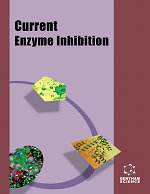- Home
- A-Z Publications
- Current Enzyme Inhibition
- Previous Issues
- Volume 19, Issue 1, 2023
Current Enzyme Inhibition - Volume 19, Issue 1, 2023
Volume 19, Issue 1, 2023
-
-
Synthesis, In-silico and In-vitro Antimycobacterial Studies on Novel Benzofuran Derivatives
More LessAuthors: Dnyaneshwar E. Shelke, Bapu R. Thorat, Sanjay S. Dhabarde and Suraj N. MaliBackground: Benzofurans, interesting heterocyclic compounds, are available abundantly in nature and show a wider range of pharmacological activities. Moreover, in recent years this moiety has been found to have strong antituberculosis potential. Considering the importance of this moiety in the field of medicinal chemistry, we have synthesized a few benzofuran derivatives. Methods: These derivatives were also characteriz Read More
-
-
-
Plant Alpha-amylase Inhibitors: Steady Kinetic Study, Bidens odorata Aqueous Infusion Toxicity and Stability in Digestive Tract Simulation
More LessBackground: α-Amylase inhibitors are considered an important therapeutic target to control type 2 diabetes mellitus, reducing postprandial hyperglycemia. Medicinal plants are an important source with inhibitory activities of this enzyme but are little studied. Objective: The present study explored the α-amylase inhibition with extracts of 11 medicinal plants available in Saltillo, Mexico; the kinetic mechanism of inhibition of Read More
-
-
-
GC-MS Identification of Cholinesterase Inhibitory and Antioxidant Molecules from Leaves of Cnidoscolus aconitifolius (Miller) I.M. Johnston (Euphorbiaceae)
More LessAuthors: Onoja O. Joel and Ugwueze Nnamdi JoachinBackgound: Alzheimer’s disease (AD) is a progressive and fatal neurodegenerative disease, clinically characterized by memory and cognitive dysfunction. AD affects about 35 million people worldwide today and is estimated to nearly double every 20 years. Cnidoscolus aconitifolius (Miller) I.M. Johnston has been reported in Nigerian ethnomedicine as a memory enhancer. There is a lack of scientific evidence to justify the cla Read More
-
-
-
Rational Drug Design and In vitro Cell Line Studies of Some N-(4-(1Hbenzo[ d]imidazol-2-yl)phenyl)arylamine Derivatives as Aromatase Inhibitors for the Treatment of Cancer
More LessAuthors: Nusrat B. Sayyad and Prafulla M. SabaleBackground: Aromatase is a catalytic enzyme involved in the biosynthesis of estrogen from androgen. It catalyzes the last rate-limiting/crucial critical step in estrogen biosynthesis. Following the success of the aromatase inhibitor, researchers are working on developing a small physiologically active molecule with fewer side effects and improved tolerance. Objectives: Inhibition of the aromatase enzyme, which pl Read More
-
-
-
Aromatase Enzyme Activity and Liver Receptor Homolog-1 Levels in Gestational Diabetes Mellitus
More LessAuthors: Nihayet Bayraktar, Hasip Tas, Mehmet Bayraktar, Ismail Koyuncu, İsmail Sarı and Hacer UyanıkoğluBackground: Gestational diabetes mellitus (GDM) is one of the prediabetes conditions in which high blood sugar levels and body weight increase during pregnancy. The underlying molecular and biochemical mechanisms of GDM have been poorly defined. Introduction: Aromatase enzyme activity is responsible for the conversion of androgens to estrogens and has a share in the regulation of body fat distribution and liver re Read More
-
-
-
Syringin as TGF-βR1, HER2, EGFR, FGFR4 Kinase, and MMP-2 Inhibitor and Potential Cytotoxic Agent against ER+ Breast Cancer Cells
More LessAuthors: Charlaine A. Aventurado, Agnes L. Castillo and Ross D. VasquezBackground: Breast cancer is currently the most diagnosed cancer worldwide. Neoplastic cells and components of the tumor microenvironment trigger enzymes and receptors to facilitate cancer advancement. Syringin, a natural phenylpropanoid glycoside, has been reported to possess anti-cancer activity and affinity with numerous druggable targets of breast carcinoma. Objectives: This work aims to evaluate the effects of s Read More
-
-
-
Cholinesterase Aging Phenomenon Following Acute Ethoprophos Poisoning: A Case Report
More LessAuthors: Bilel Chefirat, El Haouaria Touer, Nour E. H. Bensaid and Haciba Rezk-KallahBackground: Acute poisoning by Ethoprphos, an organophosphorus pesticide, leads to a veritable cholinergic syndrome whose diagnosis is based on the determination of cholinesterase activity. The treatment relies on the administration of atropine and pralidoxime to regenerate cholinesterases before their ageing. Case: We report a case of a two-year-old child, hospitalized for ethoprophos poisoning, with seizures associated with Read More
-
Volumes & issues
-
Volume 20 (2024)
-
Volume 19 (2023)
-
Volume 18 (2022)
-
Volume 17 (2021)
-
Volume 16 (2020)
-
Volume 15 (2019)
-
Volume 14 (2018)
-
Volume 13 (2017)
-
Volume 12 (2016)
-
Volume 11 (2015)
-
Volume 10 (2014)
-
Volume 9 (2013)
-
Volume 8 (2012)
-
Volume 7 (2011)
-
Volume 6 (2010)
-
Volume 5 (2009)
-
Volume 4 (2008)
-
Volume 3 (2007)
-
Volume 2 (2006)
-
Volume 1 (2005)
Most Read This Month
Article
content/journals/cei
Journal
10
5
false
en


